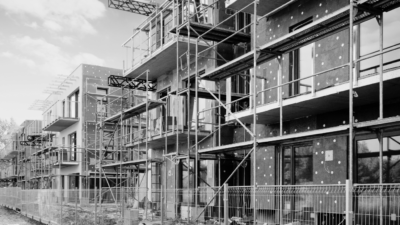In the latest Halifax House Price Index for May, house prices were largely unchanged in May, edging down very slightly (-£130) compared to April, with the average UK property now costing £286,532.
More notably the annual rate of growth fell to -1.0%, marking the first time since 2012 that house prices have fallen year-on-year.
Given the effectively flat month, the annual decline largely reflects a comparison with strong house prices this time last year, as the market continued to be buoyant heading into the summer.
Property prices have now fallen by about £3,000 over the last 12 months and are down around £7,500 from the peak in August.
But prices are still £5,000 up since the end of last year, and £25,000 above the level of two years ago.
As expected the brief upturn we saw in the housing market in the first quarter of this year has faded, with the impact of higher interest rates gradually feeding through to household budgets, and in particular those with fixed rate mortgage deals coming to an end, said Kim Kinnaird, Director, Halifax Mortgages.
With consumer price inflation remaining stubbornly high, markets are pricing in several more rate rises that would take Base Rate above 5% for the first time since the start of 2008.
Those expectations have led fixed mortgage rates to start rising again across the market.
This will inevitably impact confidence in the housing market as both buyers and sellers adjust their expectations, and latest industry figures for both mortgage approvals and completed transactions show demand is cooling.
Therefore further downward pressure on house prices is still expected.
One continued source of support to house prices is the labour market.
While unemployment has recently ticked up from very low levels, brisk wage growth would over time help to improve housing affordability, if sustained.
| Average house price | Monthly change | Quarterly change | Annual change |
|---|---|---|---|
| £286,532 | 0.0% | +1.3% | -1.0% |
Buyer and property types
Prices remain under most pressure among homemovers.
Annual growth fell by -1.1% in May, compared to ongoing marginal inflation for first-time buyers (+0.3%).
Existing houses continued to fall in value (annual growth of -1.9%), whereas prices for new build properties are still rising (+2.8%), although at the weakest rate for nearly three years.
By property type, all except for detached houses (+0.4%) have registered year-on-year declines.
The sharpest drop is for flats (-1.9%), followed by terraced (-1.0%) and semi-detached houses (-0.5%).
Nations and regions house prices
Prices continue to fall on an annual basis across southern England, again led by the South East (-1.6%, average price £385,943), and closely followed by the South West (-1.4%, average price £301,079).
In Greater London prices are down over the last year by -1.2% (average price £536,622).
Except for Wales (unchanged at +1.1%, average price £218,365), all areas of the UK have seen annual house price growth weaken in May compared to April, with most now recording a low single-digit rate of property price inflation.
The West Midlands (+2.7%, average price £251,137) remains the best performing region, followed by Yorkshire & Humberside (+2.3%, average price £205,035).
Scotland (average price £201,596) saw annual growth drop to +1.3% (from +2.2% in April).
In Northern Ireland (average price £187,334) growth was +1.5% over the last year (from +2.7% in April).
Housing activity
HMRC monthly property transaction data shows UK home sales decreased in April 2023.
UK seasonally adjusted (SA) residential transactions in April 2023 totalled 82,120 – down by 7.9% from March’s figure of 89,210 (down 29.2% on a non-SA basis).
Quarterly SA transactions (February 2023 – April 2023) were approximately 11.6% lower than the preceding three months (November 2022 – January 2022).
Year-on-year SA transactions were 25.1% lower than April 2022 (32.5% lower on a non-SA basis). (Source: HMRC)
Latest Bank of England figures show the number of mortgages approved to finance house purchases decreased in April 2023, by 5.4% to 48,690.
Year-on-year the April figure was 26.0% below April 2022. (Source: Bank of England, seasonally-adjusted figures)
The April 2023 RICS Residential Market Survey results continue to show weak momentum in the sales market.
New buyer enquiries returned a net balance of -37%, down from -30% in each of the last two months.
Agreed sales had a net balance of -19% (up from -30% previously) and new instructions returned a net balance of -4% (previously -6%). (Source: Royal Institution of Chartered Surveyors’ (RICS) monthly report)
Tom Bill, head of UK residential research at Knight Frank, comments:
“This is unlikely to be the last national house price index to fall into negative territory this year. Mortgage rates will keep edging up as wage growth keeps core inflation stubbornly high and we expect prices to fall by around 5% this year.
However, this isn’t the global financial crisis part two for house prices and any decline will be kept in check by rising wages, low unemployment, cash sales, record-high levels of housing equity, longer mortgages and savings amassed during the pandemic.
The UK housing market is coming back down to earth after a strong three years, not falling off a cliff.”
Jeremy Leaf, north London estate agent and a former RICS residential chairman, comments:
“Halifax, like the Nationwide figures, exclude cash sales and reflect activity from a few months ago.
However, they do confirm recent trends that tentative market recovery is being threatened by the prospect of more interest rate rises and stubbornly high inflation.
However, the survey shows prices are still considerably above where they were two years ago so cash and equity-rich buyers in particular are recognising the opportunities.
Many mortgage holders too will be relieved that their lenders built in a buffer of at least 2 or 3 percentage points at the outset, provided of course their circumstances have not substantially changed.”
Mark Harris, chief executive of mortgage broker SPF Private Clients, comments:
“Lenders continue to increase their mortgage rates, pulling products with little or no notice in response partly to funding costs and in response to what other lenders are doing.
This will inevitably impact what buyers can afford and in some cases they may put decisions on hold until the situation irmproves.
Swap rates, which underpin the pricing of fixed-rate mortgages, have settled since the inflation news sent them soaring.
If this continues, we would expect mortgage pricing to also become less volatile.
Borrowers coming up to remortgage who are worried about their options should seek advice from a broker and consider reserving a rate for peace of mind.
If rates fall before they need it, they could always opt for a cheaper product.”
Gareth Lewis, managing director of property lender MT Finance, comments:
“These numbers are unsurprising, given the fall in transactions.
They also reflect that those who are willing to buy are less bullish when it comes to committing to higher house prices because everything is costing more, so the are going to chip away at the price.
Mortgage borrowers on the whole, other than perhaps some first-time buyers, can still afford a mortgage but just have to be prepared to put their hand in their pocket a bit more.
This is all part of what is essentially a re-education process; money isn’t free and you are going to have to pay more for it in future.
The housing market will inevitably be quieter as a result.”
Kate Anderson, Deputy editor at personal finance comparison site finder.com, comments:
Although house prices did fall very slightly last month, the fact that hundreds of mortgage deals were pulled from the market just last week as lenders seek to raise rates once again, shows that there are no real winners in the current situation.
First time buyers may now struggle to find an affordable mortgage rate, and could therefore still be unable to purchase despite reduced prices.
This will put more people at risk of being stuck with extraordinarily high rental rates, at a time where the cost of living is already through the roof and people are struggling to afford the basics such as food and paying their bills.
With wide speculation that the Bank of England is likely to put rates up once again this month, house prices could continue to restrict under this pressure.
It’s likely that we’ve not seen the end to these shrinking house prices just yet.”
David Hannah, Chairman at Cornerstone Group International, discusses the effect of rising rates on the property market:
“The latest house price data from Halifax, highlighting that house prices have experienced its first annual decline since 2012, will be welcome news for homebuyers, and in particular, first-time buyers.
However, there are still significant obstacles when looking to purchase a home.
A rise in mortgage rates due to inflation figures being stronger than expected is unwelcome news for homeowners.
However, I believe that the housing market has recently shown significant resilience, and I have a positive outlook for the remainder of the year.
Prices are starting to stabilize, which will hopefully boost lender confidence.
Of course, lenders will adjust rates according to interest rates, but if they see inflation moving in the right direction, that will be crucial.”
























Comments